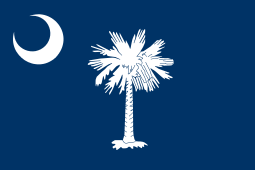Naval Support Activity Charleston
Coordinates: 32°51′09″N 79°57′24″W / 32.85250°N 79.95667°W
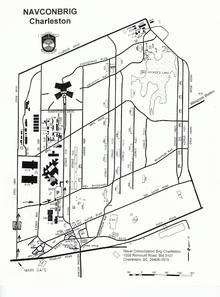
Naval Support Activity Charleston, originally designated Naval Weapons Station Charleston, is a base of the United States Navy located on the west bank of the Cooper River, in the cities of Goose Creek and Hanahan South Carolina.[1][2][3][4] The base encompasses more than 17,000 acres (69 km²) of land with 10,000 acres (40 km²) of forest and wetlands, 16-plus miles of waterfront, four deep-water piers, 38.2 miles (61.5 km) of railroad and 292 miles (470 km) of road. The current workforce (military/civil service/contractor) numbers more than 11,000 with an additional 3,600 people in on-base family housing.[5]
Under the 2005 Base Realignment and Closure plan the Air Force is to jointly manage Naval Weapons Station Charleston and Charleston Air Force Base as Joint Base Charleston.[6]
History
Commissioned on November 5, 1941 as the United States Naval Ammunition Depot, (NAD) consisted of 6,368 acres this is now the Station’s Southside area including the Cooper River waterfront. The facility was used as an ammunition collection and distribution point during World War II. Ammunition manufactured throughout the country was sent to the base and then used to supply ordnance to Atlantic fleet vessels. Following WWII, the Depot was charged with the removal of ordnance from ships being deactivated and was used as a weapons storage site. The NAD’s status changed from caretaker to inactive to maintenance to active from 1947 through 1952.
During the mid-1950s, the installation was expanded, the Northside area, another 5,219 acres, was acquired by the Navy in January 1954 and called the Naval Weapons Station Annex and charged with new duties that included the handling of guided missiles and the docking, servicing and loading of submarines. Base personnel were tasked with arming submarines with the UGM-27 Polaris missile.
In 1960 the Polaris Missile Facility Atlantic (POMFLANT) was constructed within the base to enable the handling of Terrier, Tarter, and, Hawk, missiles. Buildings were added again in 1969 for the Standard and Red Eye missiles. The base continued to grow through the 1970s, the Marrington area, an additional 2,894 acres located between Red Bank Road and Foster Creek, was added to the Station. The Navy designated the eastern half as the Marrington Plantation Outdoor Recreation Area and used the western half for the construction of MenRiv Housing and the adjacent support facilities. On September 30, 1981, the Station acquired the nearby Charleston Army Depot. The station's name was then changed to Naval Weapons Station South. In 1995 POMFLANT was decommissioned and the fleet ballistic missile operations moved to Kings Bay, Georgia.
The Naval Nuclear Power Training Command school opened in 1998 and occupies over 50 acres in the central part of the original Marrington tract.
Under the 2005 BRAC the Naval Weapons Station was combined with Charleston Air Force Base to create Joint Base Charleston.
Naval Support Activity Charleston has expanded its mission and Department of Defense support role with over 40 tenant commands, and today is a training center, with the Naval Nuclear Power Training Command (NNPTC), Nuclear Power Training Unit, Propulsion Facility, and Border Patrol satellite academy; Naval Consolidated Brig, Charleston; Navy Munitions Command Unit Charleston; Explosive Ordnance Detachments; Marine Corps Reserve Center; Space and Naval Warfare Systems Center engineering complex (SPAWAR, the largest employer in the Charleston area); 269 above-ground ammunition magazines, maintenance and storage of military ordnance including mines, and serves as an Army logistics hub, the busiest continental United States surface port in the defense transportation system. In addition, it contains more than 1,800 on-base houses for Navy enlisted and officer dependents as well as Coast Guard dependents. NSA Charleston also has a child care facility, elementary and middle schools. A large medical clinic near NNPTC in Goose Creek was added in 2008.
Current status
The Naval Support Activity has expanded its mission and Department of Defense support role with over 40 tenant commands, and today is a training center, with the Naval Nuclear Power Training Command (NNPTC), Nuclear Power Training Unit, Propulsion Facility, and Border Patrol satellite academy; Naval Consolidated Brig, Charleston; Navy Munitions Command Unit Charleston; Explosive Ordnance Detachments; Marine Corps Reserve Center; Space and Naval Warfare Systems Center engineering complex (SPAWAR, the largest employer in the Charleston area); 269 above-ground ammunition magazines, maintenance and storage of military ordnance including mines, and serves as an Army logistics hub, the busiest continental United States surface port in the defense transportation system. In addition, it contains more than 1,800 on-base houses for Navy enlisted and officer dependents as well as Coast Guard dependents, and has a child care facility, elementary and middle schools. A large medical clinic near NNPTC in Goose Creek was added in 2008.[7]
Today, Joint Base Charleston, encompassing over 20,877 acres and supporting 53 Military Commands and Federal Agencies, provides service to over 79,000 Airmen, Sailors, Soldiers, Marines, Coast Guardsmen, DOD civilians, dependents, and retirees.
In supporting Joint Base Charleston, the former Charleston Naval Base has been transformed into a multi-use Federal Complex (231 acres) with 17 Government and Military tenants, as well as homeport for 6 RO-RO Military Sealift Command Ships, 2 Coast Guard National Security Cutters, and 2 NOAA Research Ships.
Tenants
Navy
- Charleston Naval Weapons Station, Joint Base Charleston (>17,000 acres, 27 square miles), Goose Creek and Hanahan
- Space and Naval Warfare Systems Center Atlantic (SPAWAR)
- Naval Nuclear Power Training Command
- Nuclear Power School
- Nuclear Power Training Unit
- Moored Training Nuclear Submarine, USS Daniel Webster (SSBN-626)
- Moored Training Nuclear Submarine, USS Sam Rayburn (SSBN-635)
- Moored Training Nuclear Submarine, USS La Jolla (SSN-701), 2015 delivery
- Moored Training Nuclear Submarine, USS San Francisco (SSN-711), After 2015 delivery
- Naval Consolidated Brig, Charleston, East Coast
- Mobile Mine Assembly Unit Eleven (MOMAU-11)
- Naval Operations Support Center Charleston
- Navy Reserve Center
- Navy Munitions Command CONUS, Detachment Charleston
- Explosive Ordnance Detachment
- Naval Health Clinic Charleston
- Navy Dental Clinic
- Naval Criminal Investigative Service Training, Federal Complex
- Lay berth for Roll-On Roll-Off Naval Ships, Military Sealift Command, Federal Complex
- MV Cape Ducato (T-AKR-5051), Military Sealift Command Ship, Ready Reserve Force, Federal Complex
- MV Cape Douglas (T-AKR-5052), Military Sealift Command Ship, Ready Reserve Force, Federal Complex
- MV Cape Domingo (T-AKR-5053), Military Sealift Command Ship, Ready Reserve Force, Federal Complex
- MV Cape Decision (T-AKR-5054), Military Sealift Command Ship, Ready Reserve Force, Federal Complex
- MV Cape Diamond (T-AKR-5055), Military Sealift Command Ship, Ready Reserve Force, Federal Complex
- MV Cape Edmont (T-AKR-5069), Military Sealift Command Ship, Ready Reserve Force, Federal Complex
Air Force
- Charleston Air Force Base, Joint Base Charleston (3,877 acres, 6.06 square miles), North Charleston
- Charleston Air Force Auxiliary Base, North, SC (2,393 acres, 3.74 square miles)
- Charleston Defense Fuel Storage and Distribution Facility, Hanahan
- 628th Air Base Wing
- 628th Mission Support Group
- 628th Medical Group
- 315th Airlift Wing
- 437th Airlift Wing
- 373rd Training Squadron, Detachment 5
- 1st Combat Camera Squadron
- 412th Logistics Support Squadron OL-AC
- Air Force ROTC Det 772
- Civil Air Patrol – Charleston Composite Squadron
Marines
- Marine Corps Reserve Center, Naval Weapons Station Which now supports 4th Medical Logistics Company
Coast Guard
- Coast Guard Sector Charleston (District 7)
- Coast Guard Station Charleston
- Coast Guard Helicopter Air Facility, Johns Island
- Coast Guard Reserves, Charleston
- Coast Guard Maritime Law Enforcement Academy, Federal Complex
- USCGC Hamilton (WMSL-753) National Security Cutter, Federal Complex
- USCGC James (WMSL-754) National Security Cutter, Federal Complex
- USCGC Tarpon, Marine Protector-class coastal patrol boat, Tybee Island
- USCGC Yellowfin, Marine Protector-class coastal patrol boat, Charleston
- USCGC Anvil, 75-foot inland construction tender, Charleston
Army
- United States Army Corps of Engineers, Charleston District
- South Carolina Army National Guard
- Army Reserve Training Center, Naval Weapons Station
- 841st Army Transportation Battalion, Naval Weapons Station
- 1182nd Army Deployment & Distribution Support Battalion, Naval Weapons Station
- 1189th Army Transportation Brigade, Reserve Support Command, Naval Weapons Station
- Army Strategic Logistics Activity, Naval Weapons Station
Federal Complex (former Naval Base Charleston), North Charleston
The former NAVBASE Charleston has been transformed into a multi-use Federal Complex (231 acres) with 17 Government and Military tenants, as well as homeport for 6 RO-RO Military Sealift Command Ships, 2 Coast Guard National Security Cutters, and 2 NOAA Research Ships.
- Federal Law Enforcement Training Centers (FLETC), Department of Homeland Security
- Moored FLETC Training Ship, SS Cape Chalmers (T-AK-5036)
- Sea Hawk Interagency Operations Center
- Customs and Border Protection Satellite Academy
- Immigration and Customs Enforcement Satellite Academy
- U.S. Courts, Federal Probation and Pretrial Services Academy
- Food and Drug Administration Training Academy
- National Oceanic and Atmospheric Administration (NOAA)
- NOAAS Nancy Foster (R 352) Ship
- NOAAS Ronald H. Brown (R 104) Ship
- U.S. Department of State
- Global Financial Services Center, U.S. Department of State
- Passport Service Center, U.S. Department of State
- United States Maritime Administration
-

Joint Base Charleston
-

United States Marine Corps
-

SPAWAR Systems Center Atlantic
-
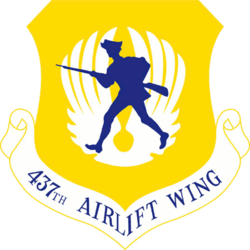
The 437 Airlift Wing
-

The 315 Airlift Wing
-
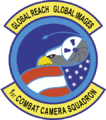
The 1st Combat Camera Squadron
-

The 412 Flight Test Squadron
-
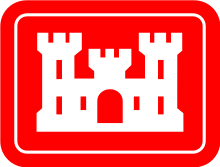
U.S. Army Corps of Engineers
References
- ↑ "History". Naval Support Activity Charleston. Retrieved February 15, 2016.
- ↑ "Goose Creek city, South Carolina." U.S. Census Bureau. Retrieved on May 30, 2010.
- ↑ "Hanahan city, South Carolina." U.S. Census Bureau. Retrieved on May 30, 2010.
- ↑ "Charleston Base Map." Naval Consolidated Brig, Charleston. Retrieved on May 30, 2010.
- ↑ About Naval Weapons Station Charleston
- ↑ Joint Basing with Naval Weapons Station moves forward, July 28, 2006.
- ↑ Jill Coley, "Military striving to fix health care ills", The Post and Courier, January 4, 2008.
External links
- NSA Charleston official website
- Joint Base Charleston official website
- globalsecurity.org: NWS Charleston
